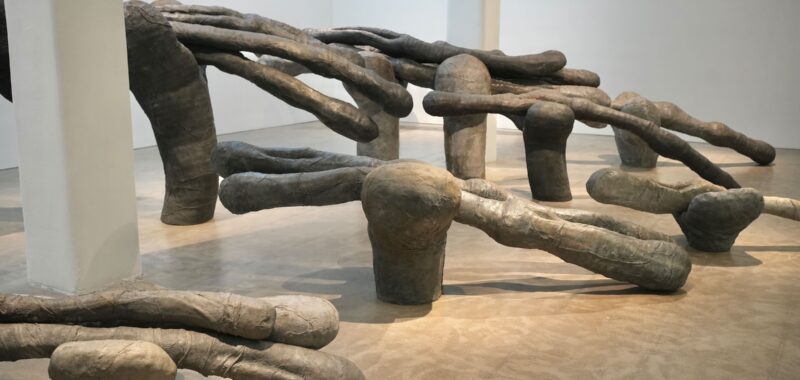Tuning out the din of fad-hunting throughout Frieze Week, a New York exhibition re-awakens a late feminist sculptor’s embodiments of human migration — both primordial and present. Mary Ann Unger, who died in 1998 at age 53 after a battle with breast cancer, left a crucial legacy of biomorphic sculptures and related drawings, as seen in a solo exhibition at Berry Campbell gallery in Chelsea, on view through May 17.
Widely considered the artist’s magnum opus, an enormous sculpture titled “Across the Bering Strait” (1992–94) takes center stage at the eponymous exhibition. Created from graphite-washed Hydrocal cement hardened over steel and cloth armatures, the work’s hulking, bulbous forms evoke evolution and migration over millennia. The structure resembles many things — fossilized dinosaur bones, fallen branches, mummified bodies, bandage-wrapped appendages, primitive tools, and bundled belongings — all evidence of organic passages across land and time.

In Unger’s original text about the work, she cites the Mongol migration over the Beringia land bridge that once connected Asia to Alaska tens of thousands of years ago as the title’s referent. The work channels her own family’s history of migration, she noted, writing that the sculpture “suggests the continuity between the journeys of our ancestors and the journeys of today.”
“We may have our hopes for an information superhighway and our dreams of an interconnected world in the technological twenty-first century, yet it is still the movements of peoples that makes us aware of each other around the world,” Unger said in her shockingly prescient 1994 statement. “Migration is arguably the strongest force towards the creation of a global village.” Those words feel more powerful now than ever.
“With the current administration’s policy on immigration, deportation, and intolerance, this installation exudes the burden and angst we feel right now,” Berry Campbell gallery co-owner Christine Berry remarked in an email to Hyperallergic. “It is hard to believe that when she created this work over 30 years ago, it would be even more relevant today.”

Berry noted that assembling “Across the Bering Strait” in its entirety in New York City for the first time makes this the gallery’s “most ambitious” exhibition to date. “When you walk into the gallery, you feel like you are joining this pack and are propelled to move with them,” she continued.
Additional works from Unger’s archive are highlighted throughout the show, including colorful standalone sculptures that play with gravity, modularity, and biomorphism, as well as various graphite sketches of her repeated “Hexagonal Quintet” motif displayed alongside its realized fiberglass variation laid out on the gallery’s floor.

Though her legacy has only recently re-emerged after a stage of dormancy, Unger was lauded for her vision before her untimely death — she was a two-time Pollock-Krasner Foundation award recipient, a three-time Yaddo Residency fellow, and a 1992 Guggenheim fellow, among other accolades. She completed multiple public commissions along the East Coast, and her work is in multiple institutional collections including the Hirshhorn Museum and Sculpture Gardens, the Brooklyn Museum, the Whitney Museum of American Art, and the Art Institute of Chicago.
The gallery announced its representation of Unger’s estate at the end of January. Berry told Hyperallergic that neither she nor co-owner Martha Campbell had heard of Unger until meeting her daughter, artist and Wassaic Project co-founder Eve Biddle.
“Knowing that she was battling cancer for years and years makes us more empowered to tell her story,” Berry said. “If she was able to carry on each day and create these massive sculptures, then we needed to find a way to share that story with the world.”



